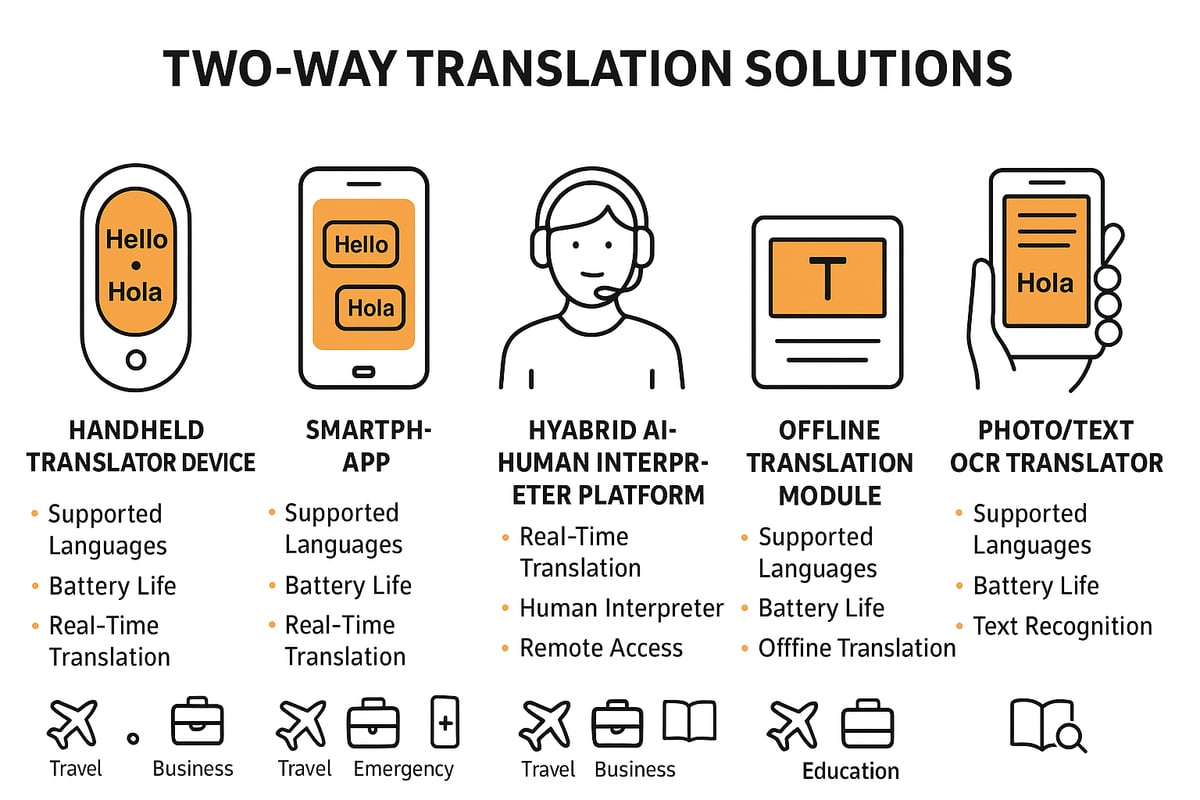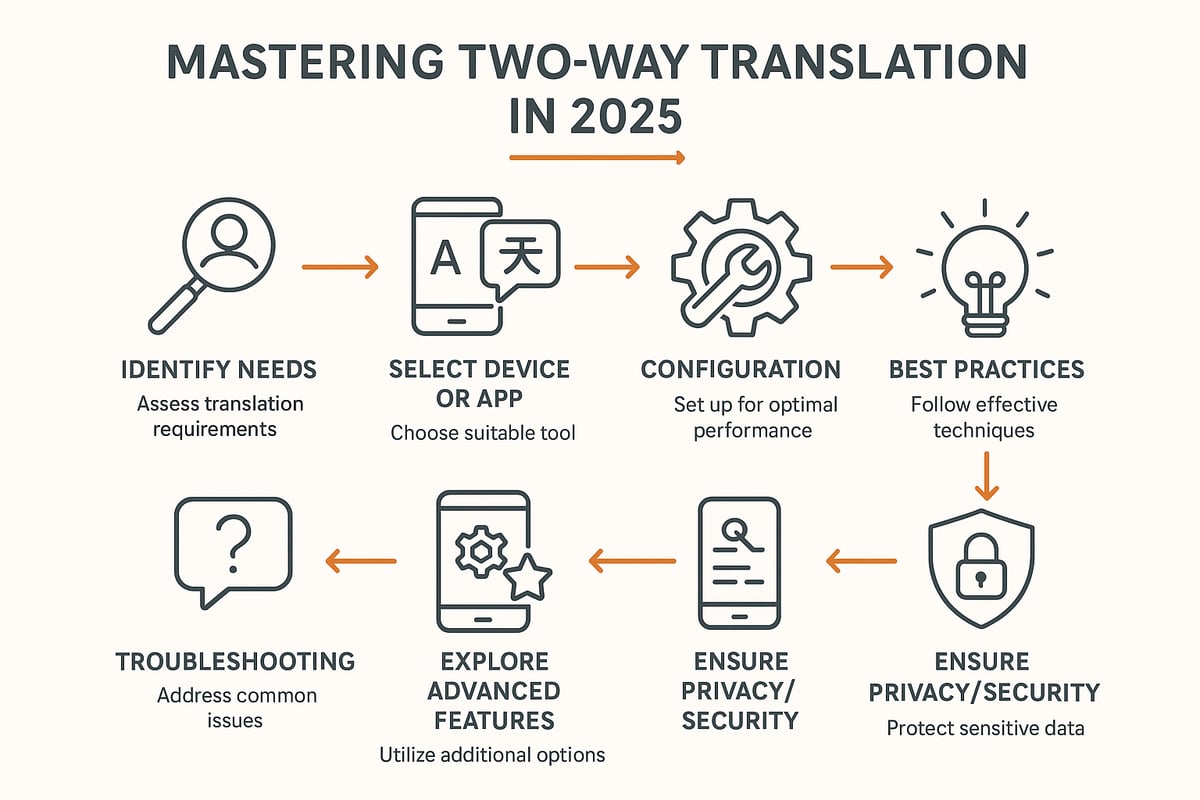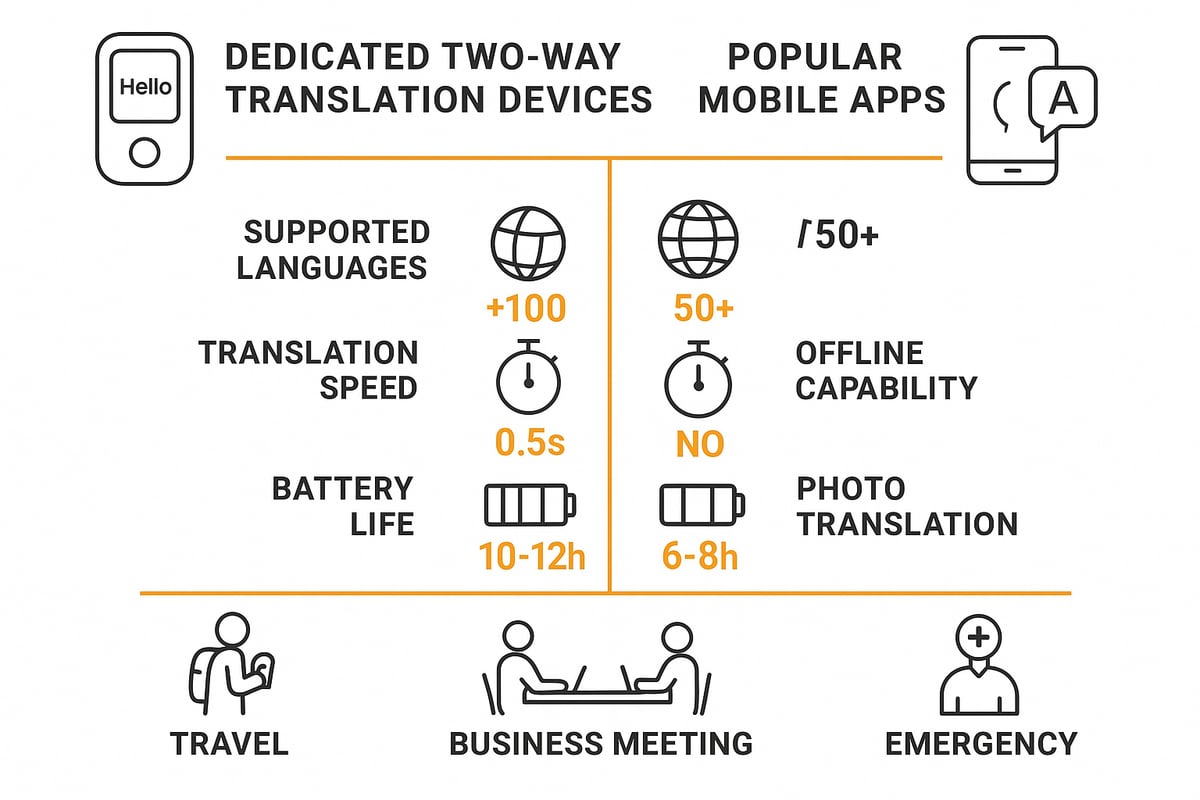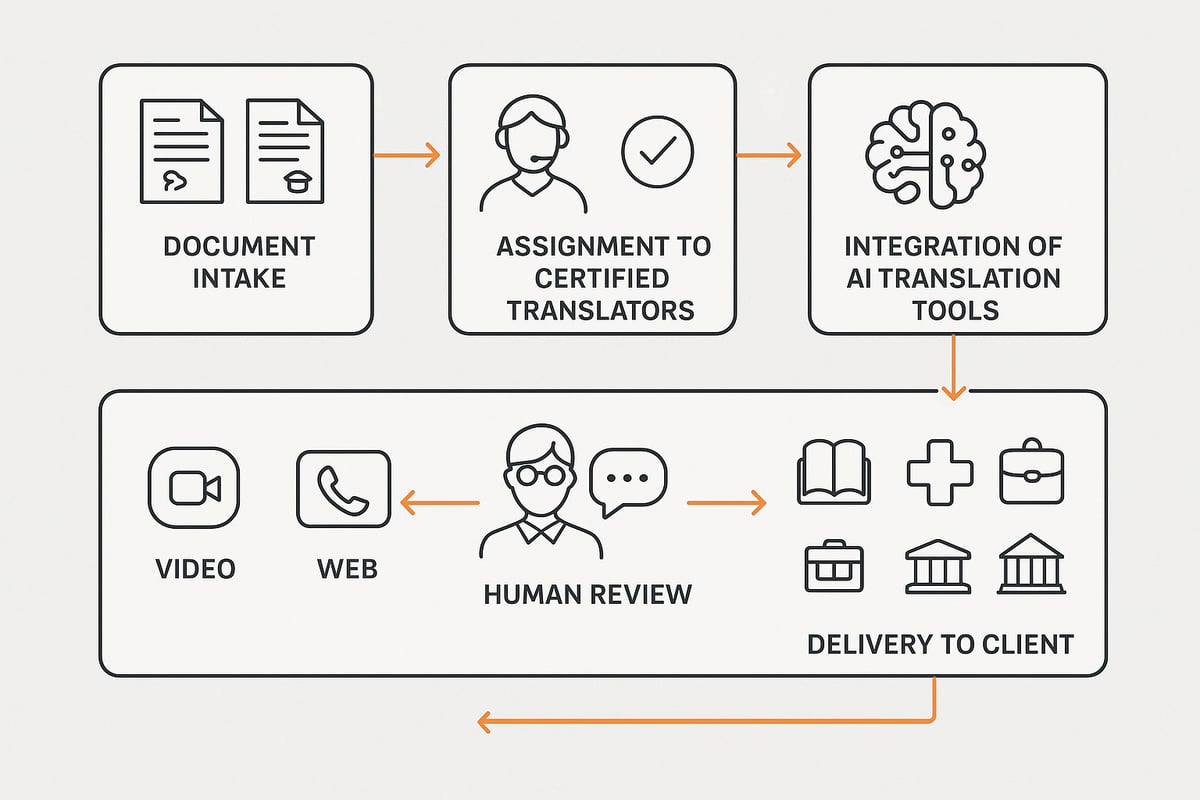Imagine being able to speak, write, or understand any language no matter where you are in the...
Two Way Translation Guide: Master Multilingual Communication 2025
In a world where global connections are just a conversation away, mastering two way translation is no longer optional—it is essential for success. International travel, cross-border business, and remote collaboration are growing rapidly, making multilingual communication a daily necessity.
Language barriers can lead to missed opportunities and frustration. Fortunately, two way translation solutions are transforming how we interact across languages, offering real-time clarity and efficiency.
This guide will equip you with everything you need to master two way translation in 2025. You will discover core concepts, key technologies, step-by-step usage, device and app comparisons, advanced use cases, and future trends to help you communicate with confidence.
Understanding Two Way Translation: Core Concepts and Evolution
Two way translation is changing how the world communicates, making it possible to have real conversations across languages. By enabling both parties to speak and understand each other in real-time, this technology is bridging cultural and linguistic divides. Let’s break down its core concepts, see how it has evolved, and understand why it is so vital in 2025.

What is Two Way Translation?
Two way translation allows two people speaking different languages to communicate seamlessly, with both sides receiving instant translations in their native tongues. Unlike one-way translation, which only translates in a single direction, two way translation ensures a genuine dialogue.
This capability is crucial for real-time conversations, such as business meetings, travel situations, or emergencies. For example, a traveler in a foreign country can ask for directions and instantly understand the reply, while a business executive can negotiate deals without a language barrier. The main benefits are mutual understanding, increased efficiency, and higher accuracy in communication.
Historical Context and Technological Evolution
Translation has come a long way. In the past, people relied on phrasebooks or human interpreters for cross-language communication. The 2000s saw the arrival of electronic translators and early translation apps, which were limited in scope and speed.
Major milestones include the integration of AI and neural networks, which brought real-time voice translation to life. The number of supported languages has grown rapidly, with modern solutions now offering 137 to 144 languages. Translation has shifted from simple text to include voice, photos, and even group conversations, reflecting how far two way translation has advanced.
The Science Behind Modern Two Way Translation
Today’s two way translation relies on artificial intelligence and machine learning to process language, recognize speech, and synthesize responses. Advanced speech recognition allows for accurate capture of spoken words, while speech synthesis delivers clear translations.
Optical Character Recognition (OCR) enables photo translation, letting users scan menus or signs. Cloud computing ensures instant updates and rapid processing speeds, with current systems achieving up to 98% accuracy and response times as fast as 0.2 to 0.5 seconds. For a deeper dive into how AI powers these advances, explore AI-powered audio translation tools.
Why Two Way Translation is Critical in 2025
In 2025, global connectivity is at an all-time high. Remote work, international business, and multicultural communities are the new norm. Two way translation is now essential for cross-border e-commerce, global teamwork, and inclusive societies.
Real-time translation is a lifeline in emergencies, where instant, accurate communication can save lives. Emergency services, for example, depend on two way translation to assist non-native speakers in critical moments. As global interactions become more common, the importance of this technology only grows.
Key Challenges and Limitations
Despite its strengths, two way translation faces hurdles. Capturing the nuances of idioms, slang, and cultural context remains difficult. Recognizing diverse accents and dialects can lead to errors, especially in noisy environments.
Offline translation offers fewer supported languages and can be less accurate than online versions. Privacy and data security are concerns, especially when sensitive information is shared. In high-stakes situations, human oversight is still needed to ensure accuracy and cultural appropriateness.
Types of Two Way Translation Solutions: Devices, Apps, and Platforms
Navigating a multilingual world is easier than ever thanks to the evolution of two way translation solutions. From dedicated devices to smart apps and hybrid platforms, users can choose the technology that best fits their needs. Let us examine the main types of solutions available in 2025.

Dedicated Two Way Translator Devices
Dedicated two way translation devices are purpose-built hardware designed for seamless multilingual communication. These handheld gadgets typically feature touchscreens, built-in microphones, and long battery life.
For instance, the MESAY device supports 138 languages, includes a 4.1-inch HD screen, and offers up to 8 hours of active use. Such devices excel in travel, business meetings, education, and fieldwork where reliability is paramount.
Pros:
- High accuracy and speed
- Works offline for select languages
- Durable and portable
Cons:
- Higher upfront cost
- Limited to device features
Dedicated devices are ideal for those who prioritize consistent two way translation without depending on a smartphone or internet connection.
Smartphone Apps for Two Way Translation
Smartphone apps bring two way translation to your pocket, leveraging the power of mobile devices. Popular apps like Google Translate, iTranslate, and Microsoft Translator support voice, text, and photo translation with group chat capabilities.
These apps integrate smoothly with mobile operating systems and even wearables, making them accessible for casual users and frequent travelers. Many support up to 137 languages and 75 photo translation options.
Pros:
- Free or low-cost access
- Regular updates and feature expansion
Cons:
- Internet often required for full functionality
- Privacy concerns for sensitive data
With a smartphone app, two way translation is always within reach, offering flexibility for a wide range of scenarios.
Hybrid and AI-Powered Platforms
Hybrid and AI-powered platforms are revolutionizing two way translation by combining advanced artificial intelligence with human interpreter support. These cloud-based solutions enable real-time group translation, conference calls, and enterprise-level deployment.
For example, some platforms provide group discussion functions that allow multi-person, real-time translation, enhancing communication in business or emergency settings. These solutions are highly scalable and accurate, though they may come at a higher cost.
To understand how these technologies blend AI efficiency with human nuance, see Human and AI interpreter integration.
Pros:
- Scalable for large groups
- High accuracy and compliance
Cons:
- Higher setup and operational costs
- Complexity in integration
Hybrid solutions are ideal for organizations needing robust, reliable two way translation across multiple contexts.
Offline vs. Online Translation Capabilities
Offline translation expands the reach of two way translation to remote or low-connectivity environments. Devices and apps offer downloadable language packages, typically supporting 16 to 17 languages offline and 130+ online.
Travelers in rural areas, emergency responders, and field workers benefit from offline capabilities. However, offline solutions often support fewer languages and may offer reduced context accuracy compared to online services.
Key points:
- Downloadable packages for offline use
- Instant translation without internet
- Limited language and context support
Offline translation ensures that two way translation remains reliable even when connectivity is uncertain.
Photo and Text Scanning Translators
Photo and text scanning translators use OCR technology to instantly translate menus, signs, and documents. Devices and apps supporting this feature can process 40 to 75 languages for photo translation.
Real-world uses include restaurant dining, navigation, and academic research. Many HD camera-equipped devices deliver fast and accurate translations, though results may vary based on image quality and lighting.
Pros:
- Quick and convenient for visual content
- Supports multiple languages
Cons:
- Dependent on camera quality
- Accuracy may drop in poor lighting
Photo and text scanning are essential additions to any two way translation toolkit, especially for travelers and students.
Step-by-Step Guide: How to Master Two Way Translation in 2025
Mastering two way translation in 2025 requires a strategic approach, clear understanding of your needs, and the right technology. By following these seven steps, you can ensure seamless multilingual communication in any situation. Whether you are preparing for international travel, business negotiations, or critical emergency scenarios, this guide will help you unlock the full potential of two way translation.

Step 1: Identify Your Translation Needs
Before diving into two way translation, start by assessing your specific requirements. Are you traveling abroad, conducting international business, responding to emergencies, or supporting education? Each context may require different languages, dialects, and features.
Make a checklist:
- What languages and dialects do you need?
- Is real-time or delayed communication essential?
- Are there privacy or data security concerns?
- Will you use the tool online or offline?
For example, an emergency responder might demand instant, reliable translation with secure data handling, while a tourist may prioritize offline support for travel. In crisis scenarios, the importance of bridging language gaps in emergencies highlights just how critical two way translation can be for saving lives.
Step 2: Choose the Right Two Way Translation Tool
Selecting an appropriate tool is vital for effective two way translation. Compare dedicated devices, smartphone apps, and hybrid platforms based on your identified needs.
Key considerations:
- Supported languages (e.g., 137–144 online, 16–17 offline)
- Special features: photo, group, offline, or recording capabilities
- Budget, portability, and battery life
For frequent travelers, a device like MESAY with robust offline functionality may be ideal. Casual users may prefer a smartphone app for convenience. Evaluate which solution aligns best with your daily scenarios.
Step 3: Set Up and Configure Your Device or App
After choosing your tool, proper setup ensures smooth operation of two way translation. Begin by selecting your source and target languages, and connect to Wi-Fi or Bluetooth as necessary.
Steps for setup:
- Download offline language packs if needed
- Calibrate microphone and speaker for clear audio input/output
- Test translation accuracy with sample phrases
- Update your app or device to the latest version
A well-configured system prevents miscommunication and maximizes reliability in real-time conversations.
Step 4: Best Practices for Effective Two Way Translation
To achieve accurate and efficient two way translation, adopt these best practices:
- Speak clearly, at a moderate pace
- Avoid idioms, slang, or overly complex sentences
- Use short, direct statements for better accuracy
- Position the device or microphone to capture speech effectively
- Double-check translations in critical or sensitive interactions
Following these habits will help ensure that translated messages remain true to your intent, especially in high-stakes environments.
Step 5: Troubleshooting Common Issues
Even the best two way translation tools can encounter challenges. Recognize common problems and apply quick solutions:
- Poor audio recognition: rephrase, speak slower, or check your microphone
- Connectivity issues: verify Wi-Fi or offline package status
- Battery or power problems: carry a backup charger or extra batteries
- Translation inaccuracies: try rewording, slow down, or repeat the phrase
- For persistent issues, consult customer support or help resources
Being prepared to troubleshoot keeps your conversations smooth and productive.
Step 6: Advanced Features and Customization
Unlock the full value of two way translation by exploring advanced functions. Many devices and apps now offer:
- Group translation and real-time conference modes
- Recording and transcription of conversations
- Integration with messaging, video calls, or other apps
- OCR for instant document or photo translation
- Personalized user profiles and preferences
Experiment with these capabilities to tailor your translation experience and address unique communication challenges.
Step 7: Ensuring Privacy and Security
Security is paramount when using two way translation, particularly with sensitive topics. Understand how your device or app stores and processes data.
Tips for privacy:
- Review data storage practices and cloud usage
- Set permissions and access controls appropriately
- Use encrypted or offline modes for confidential conversations
- Regularly check and update privacy policies
For emergency communications or healthcare, robust privacy measures are essential to protect personal information and maintain trust.
Comparing the Best Two Way Translation Devices and Apps for 2025
Selecting the right two way translation solution in 2025 requires a close look at features, usability, and real-world performance. With technology advancing rapidly, understanding how each device or app compares is essential for effective multilingual communication.

Key Criteria for Comparison
When evaluating two way translation solutions, several factors set the best options apart. Language support is crucial, with top devices and apps now handling 130 or more languages online and up to 17 offline. Speed and accuracy matter too, as leading tools deliver 98 percent or higher accuracy with response times between 0.2 and 0.5 seconds.
Other important criteria include the range of translation modes (voice, text, photo, group chat), battery life, portability, and pricing models. Subscription-based apps may offer more frequent updates, while dedicated devices often excel in reliability. The table below summarizes these criteria for easy comparison.
| Criteria | Devices | Apps | Hybrid Platforms |
|---|---|---|---|
| Languages Supported | 130+ (online) | 100+ (online) | 130+ (varies) |
| Offline Capability | 16-17 languages | 16-17 languages | Limited |
| Translation Modes | Voice, Photo | Voice, Text, Photo, Group | Voice, Group |
| Battery Life | 8-10 hours | Phone-dependent | Device/server |
| Price Model | One-time | Free/Subscription | Subscription |
Top Dedicated Devices
Dedicated two way translation devices are designed for reliability and robust performance. The MESAY Z6, for example, supports 138 languages, offers a 4.1 inch HD touchscreen, and delivers up to 10 hours of use on a single charge. It excels in both online and offline translation, including photo translation for menus or signs.
Herilary is another standout, supporting 137 languages, featuring a 3.1 inch display, and offering offline translation in 17 languages. These devices often come with advanced microphones and speakers, making them ideal for noisy environments.
Pros of dedicated devices include high accuracy, longer battery life, and offline operation. However, they tend to be pricier and less portable compared to smartphone apps, making them best suited for frequent travelers or professionals who need uninterrupted two way translation.
Leading Smartphone Apps
Smartphone apps have made two way translation more accessible than ever. Google Translate, iTranslate, and Microsoft Translator lead the market, each supporting over 100 languages for voice and text translation. Many also provide photo translation, group chat, and integration with wearables or other mobile apps.
Google Translate is popular for its free access and wide language coverage. iTranslate offers a subscription model with advanced voice and chat features, while Microsoft Translator stands out for its group translation and Office integration. The main advantages of apps are convenience, regular updates, and low cost.
However, full functionality often requires an internet connection, and privacy concerns may arise when using cloud-based translation. Still, these apps are excellent for casual users and travelers seeking flexible two way translation.
Hybrid and Enterprise Solutions
Hybrid platforms blend AI-driven translation with access to human interpreters, offering the highest accuracy for sensitive or complex scenarios. These solutions are ideal for business meetings, conferences, healthcare, and emergency response where stakes are high and nuances matter.
Enterprise-grade platforms provide real-time group translation, multi-person chat, and compliance with industry standards. They are scalable, support large teams, and integrate with cloud services for seamless collaboration. The main pros are unmatched accuracy and scalability.
Cost and setup complexity are the main drawbacks, as these platforms typically require subscriptions and may need IT involvement. Still, for organizations that depend on flawless two way translation, hybrid solutions are often worth the investment.
User Reviews and Real-World Performance
User feedback highlights the strengths and limitations of each two way translation tool. Devices like Herilary consistently score above 4 out of 5 for accuracy and ease of use, especially in travel and business settings. Common issues include battery limitations and occasional difficulties with accents or dialects.
Success stories abound in critical sectors. For instance, in healthcare, multilingual mass notification systems have enabled faster, more accurate communication between providers and patients, reducing wait times and improving outcomes. Real-world applications such as enhancing healthcare communication underscore the transformative impact of two way translation in emergencies.
As technology evolves, user experiences continue to drive improvements, ensuring that two way translation becomes even more reliable and indispensable.
Advanced Use Cases: Two Way Translation in Action
In 2025, two way translation is transforming real-world communication across industries. Let us explore how this technology powers seamless interactions in business, travel, healthcare, and education.
Business and International Collaboration
Global business thrives on clear communication. Two way translation enables real-time multilingual meetings, ensuring no participant is left behind. Teams use these tools to translate contracts, emails, and presentations instantly, supporting negotiations and onboarding across borders.
Features such as group discussion mode and multi-person translation keep international projects on track. For even higher accuracy in complex discussions, advanced frameworks like TACTIC: Cognitive-Theoretic Interactive Collaboration in Translation mimic human collaboration, combining the strengths of AI agents. This results in more precise outcomes for sensitive business contexts.
Multinational companies now rely on two way translation for everything from cross-border e-commerce to HR integration, strengthening their global reach.
Travel, Hospitality, and Tourism
Travelers face language barriers daily, from ordering food to navigating transportation. Two way translation devices and apps empower tourists with instant voice and photo translation, making foreign environments accessible and less intimidating.
Cutting-edge solutions, such as Spatial Speech Translation with Binaural Hearables, allow users to hear translated speech from multiple speakers while preserving spatial awareness. This innovation is especially useful in busy airports or group tours, where context matters.
Offline translation features support travelers in remote areas, while photo scanning helps decode menus and signs. These advances boost traveler confidence and enable smoother journeys worldwide.
Healthcare, Emergency, and Public Safety
In emergencies, every second counts. Two way translation bridges communication gaps between first responders, medical staff, and non-English speakers, helping deliver timely care and support.
Ambulance crews, 911 operators, and hospital staff use group translation for mass notifications and critical conversations. Instant translation reduces wait times for help, which can reach 5–10 minutes for non-English callers without this technology.
Devices supporting 185+ languages ensure that vital information is shared accurately, even in high-stress situations. This capability improves outcomes in healthcare and public safety, saving lives when clear communication matters most.
Education and Language Learning
Education is becoming more inclusive thanks to two way translation. International students access lectures, group work, and assignments in their native languages, breaking down barriers in classrooms and online learning environments.
Teachers leverage real-time translation for instructions and feedback, while students use language scanning pens for text-to-speech and photo translation of study materials. Integration with e-learning platforms ensures a seamless experience.
By supporting multilingual collaboration, two way translation creates equitable opportunities for learners everywhere. This technology fosters a truly global classroom, preparing students for success in a connected world.
The Future of Two Way Translation: Trends and Innovations for 2025 and Beyond
As technology rapidly evolves, the future of two way translation is set to transform global communication. Users can expect broader language coverage, smarter AI, seamless device integration, and stronger privacy protections. Let’s explore the innovations shaping two way translation in 2025 and beyond.
Expanding Language and Dialect Support
The landscape of two way translation is rapidly expanding to include more languages and dialects than ever before. Industry leaders are moving beyond the previous threshold of 130 supported languages, with some platforms now boasting coverage of 185 or more.
This trend is making two way translation accessible for speakers of regional dialects and minority languages. AI-driven tools can now auto-detect and switch between languages in real time, reducing friction in multilingual interactions.
As a result, two way translation is becoming more inclusive, breaking down barriers for users in business, education, and emergency situations. The ability to communicate instantly across diverse linguistic backgrounds is now within reach, empowering global communities.
AI, Neural Networks, and Contextual Understanding
AI is revolutionizing two way translation through advances in neural networks and contextual processing. Modern systems are achieving over 98 percent accuracy and sub-second response times, thanks to smarter algorithms that learn and adapt to user preferences.
Context-aware translation is now possible, allowing platforms to handle idioms, slang, and cultural nuances more effectively. Real-time learning enables these systems to improve with every conversation. Integration with smart assistants and devices brings two way translation into daily life, from meetings to casual chats.
Emerging research, such as Overcoming Latency in On-Device Speech Translation, highlights how simultaneous translation approaches are reducing lag and enhancing quality. These advancements ensure that two way translation will continue to deliver natural, fluid communication experiences.
Integration with IoT and Wearables
The next evolution of two way translation involves deep integration with IoT and wearable technology. Smart earbuds, AR glasses, and watches are being equipped with real-time translation features, enabling hands-free multilingual conversations.
In logistics, fieldwork, and travel, users benefit from instant access to translation without reaching for a device. Augmented and virtual reality environments are incorporating two way translation, making cross-language interactions seamless in both physical and digital spaces.
This frictionless approach to communication is transforming how people connect, collaborate, and solve problems globally. As IoT expands, expect two way translation to become a natural extension of everyday technology.
Privacy, Security, and Ethical Considerations
As two way translation becomes more embedded in sensitive fields like healthcare, business, and emergency response, privacy and security are paramount. Transparent data handling, user consent, and compliance with regulations are now industry standards.
End-to-end encryption protects conversations, while offline modes offer greater control over personal data. Developers are also working to mitigate AI bias, ensuring ethical translation for all users.
Government-grade security is being implemented in platforms used by emergency services and public safety teams. With these safeguards, two way translation can be trusted to handle confidential and high-stakes communications, supporting users when accuracy and privacy matter most.
As we look ahead to 2025, mastering two way translation isn’t just about staying ahead—it’s about making sure every conversation counts, especially in moments that matter most. You’ve seen how the right tools can break down language barriers and empower you to connect, collaborate, and respond when every second is critical. If you want to experience firsthand how seamless multilingual communication can transform your workflow and ensure no voice goes unheard, I encourage you to Book a Demo. Let’s explore how you can bring real-time, reliable translation to your team and your community.



